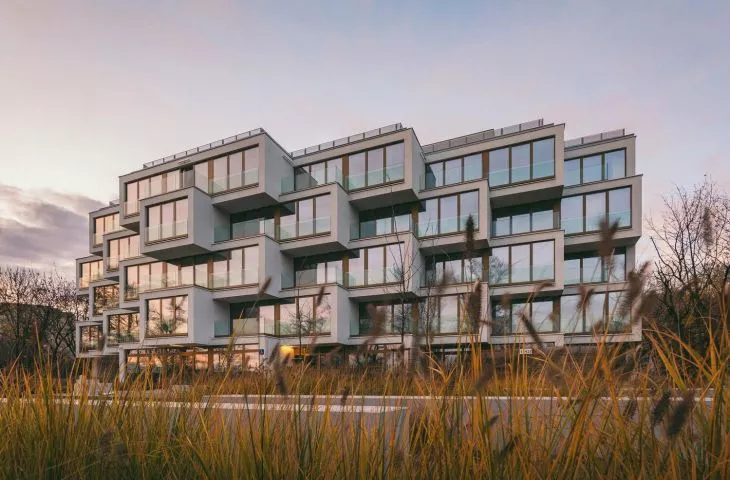On a small, rectangular plot of land in Warsaw's Żoliborz district, a sculpted residential and commercial building designed by architects from the POLE Architekci studio was built. The authors of the project talk about what influenced the irregular shape of the apartment building on Potocka Street and what was the biggest challenge.
The quarter on which the property is located is a remnant of the old urban and geodetic layout on which the Marymont-Potok estate was built. Compared to the tall buildings of the communist-era housing estate and the large Marymont sports complex, the size of the plot seems modest. However, in order to preserve the original character of the place, this particular historic quarter was divided into small plots. Neighboring wooded plots, whose legal status has not yet been settled, will not be developed for a long time, so although the Local Plan recommended creating a continuous frontage in this place, the building opens up to the four sides of the world. Thus, residents of the free-standing building can enjoy the natural advantages of the surroundings.
block shaping scheme
© POLE Architects
In plan, the building has the shape of an irregular rhombus, whose sides, based on eight-meter-high modules, are arranged in a stepped manner. By adding or subtracting individual modules, the sizes of the apartments were shaped. The structural reinforced concrete modules are a characteristic motif for the entire building, and shifting them in relation to each other made it possible to create space for terraces and glass bay windows.
Thanks to the resulting relief, the five-story building looks different from each side. The facade of the dynamic block, full of large glazing, was finished with bright plaster.
facade of the apartment building
photo: Jakub Certowicz
Ola Kloc: What is the reason for the irregular shape of the block?
POLE Architects: The shape of the block depended on a few factors. Location conditions, solar exposure and division into structural modules. The Local Plan called for the creation of frontage, but the neighboring plots were not developed and probably won't be for a long time, as they have ownership problems. On the other hand, we wanted the building to have four elevations, without blind gable walls. The surrounding greenery suggested that the building could open up to the side sectors, not just the street as in the case of buildings in continuous development. We wanted to take advantage of this. In addition, the rear elevation was deprived of sunlight. That's why the building is diamond-shaped in plan and opens to the four sides of the world. An additional characteristic element is the modules. Through variable tectonics, we were able to shape a 3D facade in which balconies and windows functionally respond to the needs of users.
Ola: What was a priority for you in this project?
POLE Architects: We wanted to create a building that would meet the investor's expectations, respond to legal and planning regulations, and respond to contemporary architectural creeds and the needs of future residents. Here it should also be added that the investor fully trusted us with design issues and we uncompromisingly implemented our assumptions. As a result, the building is consistent and coherent.
rear elevation
Photo: Jakub Certowicz
Ola: What was the biggest challenge, and what are you most satisfied with?
POLE Architects: The biggest challenge was to convince officials that the proposed form is within the rules of the Local Plan and technical conditions. The non-standard solution and our approach to frontage development raised doubts, but in the end we managed to convince the district authorities that a frontage building can open to four sides, and a blind gable wall can be interesting. We are grateful for the confidence of officials and investors.


























































